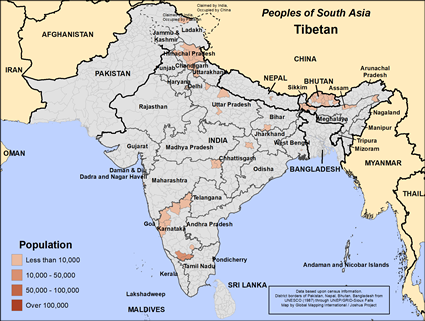Tibetan in Pakistan

Photo Source:
szyj351 - Pixabay
|

Map Source:
People Group data: Omid. Map geography: UNESCO / GMI. Map Design: Joshua Project
|
| People Name: | Tibetan |
| Country: | Pakistan |
| 10/40 Window: | Yes |
| Population: | 6,900 |
| World Population: | 1,104,400 |
| Primary Language: | Balti |
| Primary Religion: | Buddhism |
| Christian Adherents: | 0.00 % |
| Evangelicals: | 0.00 % |
| Scripture: | Portions |
| Ministry Resources: | No |
| Jesus Film: | Yes |
| Audio Recordings: | Yes |
| People Cluster: | Tibetan |
| Affinity Bloc: | Tibetan-Himalayan Peoples |
| Progress Level: |
|
Introduction / History
Written records of Tibetan history have survived from the seventh century AD, but it is known that nomadic tribes roamed Tibet as early as the second century BC. The cradle of Tibetan civilization is the Yarlung Valley area, about 80 kilometers (49 mi.) southeast of Lhasa. There, according to tradition, the union of a monkey and a she-devil created the Tibetan people. Around AD 600 the warrior-king of Yarlung, Namri Gampo, unified the clans of Tibet. He acquired a princess from Nepal and another one from China to be his wives. Under the persuasion of these two women, he combined the ancient Tibetan religion of Bon with Buddhist teachings.
Although the Tibetans strongly maintain they are one people and are opposed to any attempts to classify them as separate groups, the Tibetan nationality clearly divides into numerous linguistic components. Central Tibetan contains five dialects and is more commonly known as Central Bus. Educated people from other areas of Tibet traditionally retained their local variety and learned the literary variety of Central Tibetan.
For centuries the Chinese have claimed Tibet as an "unalienable part of China," despite Tibetans being culturally, historically, linguistically, and religiously distinct from Chinese. Communist China invaded Tibet in 1950. The Dalai Lama and a million Tibetans fled their homeland. They have been replaced by Han Chinese people who hold the best paying jobs and government positions. The Tibetans are second class citizens in their own country. China is forcing Tibetans to speak Mandarin as their first language.
Many Tibetans are now in India, but some live in Pakistan and other countries.
What Are Their Lives Like?
The Tibetans of Pakistan have tried to maintain their culture and way of life in their new home. Taking care of yaks, sheep, and goats has been their traditional occupation. Some Tibetans have taken up agriculture as a way to make a living. They farm barley, wheat, maize, vegetables and potatoes in the high valleys of northern Pakistan. The Tibetans trade their animals, dairy products and excess produce for things they cannot make for themselves such as cell phones and appliances. Life is challenging in the high mountains of Pakistan.
The Tibetans living in Pakistan have to learn Urdu, national language of Pakistan. Pakistani public schools use Urdu as the language of instruction. Although young people speak Central Tibetan at home, they are in danger of losing their Tibetan culture the longer they live in Pakistan. Most Pakistani Tibetans would move back to Tibet if there was a change in government.
Pakistani Tibetans marry within their group. Having one spouse is the norm. Many children die before their tenth birthday due to the lack of access to modern medical care.
What Are Their Beliefs?
The large majority of Tibetans see the Dalai Lama as the spiritual and political leader. He is currently living in exile in India. The Tibetan Buddhist religion is the life-blood of the Tibetan people. It was placed over the Tibetan religion of Bon, which is a mixture of folk religion, magic, divination, demon worship, and sacrifices. The patron saint of Tibet is Chenrezig, whose image has up to 11 heads and from 2 to 1,000 arms.
Buddhism is the major world religion based on the teachings of Siddhartha Gautama or the Buddha, who lived in the 6th and 5th century BC in ancient India. The Buddha taught the Four Noble Truths by which one can gain spiritual knowledge and escape the endless cycles of reincarnation. Mahayana Buddhism, the one of the two main branch of Buddhism, asserts that by following the six perfections that a Buddhist can move along the path to Enlightenment. Tibetan Buddhism falls within the Mahayana school.
To most Buddhists, however, these things have far less importance than their traditional beliefs, which are usually animistic. In animism, evil spirits must be appeased through prayers, sacrifices and rituals. Buddhism allows people to mix Buddhist teachings with traditional religion.
Two of the important Buddhist yearly holidays are Vesak, the Buddha's birthday celebrated in May or June and Bodhi Day, the holiday in December or January which commemorates the day that the historical Buddha experienced enlightenment under a Bodhi tree.
What Are Their Needs?
The Pakistani Tibetans would benefit by access to modern medical care. Pakistani Christians can teach them Urdu. Most of all, Tibetans need to hear and respond to the good news of Jesus Christ. He alone can forgive their sins and free them from the fear of evil spirits.
Prayer Points
Pray for the spiritual blindness and bondage to the evil one to be removed so Tibetans can understand and respond to Christ.
Pray God will have mercy on the Tibetans, doing whatever it takes to place them in a position to receive him.
Ask God to open the hearts of the Tibetans in Pakistan to the gospel.
Pray for an unstoppable movement to Christ among Pakistani Tibetans.
Pray for a regime change that would allow the Tibetans to return to their homeland.